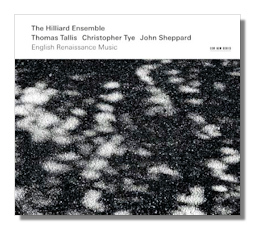
The Internet's Premier Classical Music Source
Related Links
-
Sheppard Reviews
Tallis Reviews
Tye Reviews - Latest Reviews
- More Reviews
-
By Composer
-
Collections
DVD & Blu-ray
Books
Concert Reviews
Articles/Interviews
Software
Audio
Search Amazon
Recommended Links
Site News
 CD Review
CD Review
Audivi vocem

English Renaissance Music
- Thomas Tallis:
- Audivi vocem
- In ieiunio et fletu
- Te lucis ante terminum
- Salvator mundi
- John Sheppard:
- Gaudete celicole omnes
- Beati omnes
- Laudate pueri Dominum
- Eterne rex, altissime
- Christopher Tye:
- Omnes gentes
- In pace, in idipsum
- Missa Sine Nomine: Gloria, Credo, Sanctus, Agnus Dei
Hilliard Ensemble
ECM New Series 1936 DDD 72:08
All three composers in this program were active in England during the middle of the 16th century. They were subjects of Henry VIII, Edward VI, Mary I, and (with the exception of Sheppard, who died in 1558) Elizabeth I – in other words, the Tudors. England underwent momentous changes during the Tudor era, not least in religion, and with changes in religion came changes in sacred music. The music on this CD, however, was written during the latter part of the reign of Henry VIII (1509-47) – a "musicologically grey" period, according to the annotations. It is "grey," I suppose, because it predated many liturgical changes soon to come, even though Henry had supplanted the pope as head of the church in England in 1534. Church music, it seems, changed more slowly than the church around it. Tellingly, all of the repertory here is sung in Latin. (English translations are provided in the booklet.) English came later.
Tallis is becoming increasingly familiar, but we still have some way to go with Sheppard and especially with Tye. Sheppard is one of my favorite composers from the Tudor era. His textures are dense but not over-written, and his harmonies seem almost sensuous to me. Beati omnes is a particularly good example of his work. At times the music is as hypnotic as watching waves cresting and breaking on the shore. Tye is represented by four movements of a "mass without a name." The tenor part has been lost, and was reconstructed for this recording. Was a "Benedictus" movement lost too, or did it ever exist? One could argue over the wisdom of interspersing the four mass movements with motets by other composers, as the Hilliard Ensemble has done here. I guess they figured that the mass' fragmentary state allowed them to fragment it even more!
The Hilliards, whose membership has changed over the years, are David James (countertenor), Rogers Covey-Crump and Steven Harrold (tenors), Gordon Jones (baritone), and Robert Macdonald (bass). This means that the performances are essentially one voice to a part. It probably would be more authentic (and grander) to perform these works with a larger ensemble, but there's no arguing with the clarity and scope of the Hilliards's approach; they let you see both the completed architecture and the framework underneath. These are intimate performances, private and devout in mood, and lacking any technical flaws whatsoever. Pitch, color, and voice-matching are just about perfect.
The annotator is David Skinner, a musicologist who prepared the performing scores for this recording. He was one of the co-founders of Cardinall's Musick, and now works with vocal consort Alamire. One hopes that his work here will make this repertory available to other ensembles and choirs as well.
The churchy acoustic of the Propstei St. Gerold is fitting for the repertory, and does tend to make the Hilliard Ensemble sound larger than its five voices!
Copyright © 2009, Raymond Tuttle





















